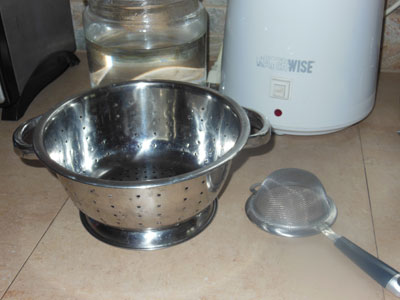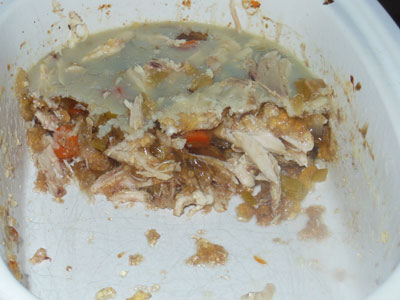How to Make Homemade Bone Broth
You've probably heard lots of health benefits of eating bone broth, and
you may have even gone so far as to find bone broth at the grocery
store, where it remained on the shelf due to its high price. I've bought
a number of cartons of bone broth myself, as well as make my own, and I
can tell you that there is no comparison between the two.
My own homemade bone broth has MUCH more collagen than the store bought
bone broth. How can I tell? Collagen looks like Jell-O when cold; it's
solid. The store bought bone broth is still liquid and pours easily from
its container when refrigerated. It is also made with lots of additional
ingredients that aren't necessary. Most taste tests reveal that homemade
bone broth with just bones and water (and a little apple cider vinegar)
is better than bone broth using more complicated recipes.
Here is what I do with a whole chicken (from Natural Grocers, about $16)
First, I use the chicken for a meal by placing it in a slow cooker with carrots, celery, and onions. If I have no homemade bone broth, I use a store bought one, but you can also use water (about 32 oz). Just add it to the slow cooker. I cook for about 6 hours on high. This process alone will provide some collagen to the soup. I take out the whole chicken, let it cool for a few minutes, and then pull off the meat and put it back in the slow cooker with the veggies and broth. (You can also roast a chicken in the oven and get the bones from that).
Now I have chicken bones, plus the soup I just made!
What Do I Do With the Bones?
I place the bones in a pot, and cover them with distilled water. I add about 2 tablespoons Bragg's Apple Cider Vinegar w/ the mother, and put the pot on the stove (or wood burning stove in winter!) Leave it simmering, loosely covered, for up to 48 hours (I usually do about 24). Add water as necessary. If you leave it simmering overnight, please make sure you add adequate water! If it boils out too rapidly, you will have nothing but a dry pile of bones and a pot you will have to scrub.

After the bones are done cooking, separate the solids from the broth. I use a colander first to get the big pieces out, then a strainer with smaller holes. I usually refrigerate until I'm ready to make another chicken, and sometimes I use the bone broth for gravy. It's also good to sip when you are having digestive problems. I've kept it up to a week in the back of the fridge. If you plan on waiting longer than that, I would probably freeze it.
(Continue reading to the bottom to see what to do with the leftover bones!)
Here is what my chicken bone broth soup looks like before re-heating. It is so solid that it stays in place. When heated, it becomes a soup with chicken and veggies. And it's so yummy that my daughter not only packed some for her lunch today, she also ate it for breakfast!

This might seem like a lot of work for something we can buy at the store...except we can't. The quality is just not there. Bone broth has all the benefits below, and I don't know if the store bought can compare at all when it comes to the benefits of homemade.
Bone broth contains...
Glycosaminoglycans, such as Glucosamine (supports joint strength and mobility by helping to maintain the integrity of cartilage), Hyaluronic Acid (supports healthy tissues, including cell rejuvenation and skin firmness), Chondroitin Sulfate (supports healthy inflammation response as well as cardiovascular health, bone health, skin health, and healthy cholesterol levels).
Minerals and Electrolytes which are important for supporting healthy circulation, bone density, nerve signaling functions, heart health, and digestive health.
Collagen which helps to form connective tissue (allowing for easier movement) and protecting and sealing the lining of the gastrointestinal tract. Collagen is a complex protein that is a rich source of 19 amino acids, many of which must be obtained from diet.
Homemade chicken soup is the best thing to eat if you're suffering from a cold or flu. And it's just plain yummy. If the directions here aren't clear, please contact me and I can clarify! I'd love the world to learn how to “use the whole bird” and get healthy, too.
What should you do with the left over bones?
Recently I discovered my double-bagged left over bones had been eaten by one (or all) of my four pets. Seriously, the only way I knew what had been in the bags is because I could smell chicken. It. Was. Empty. I waited and watched to see which one would get sick. But none of them did. Weird.
But then I tried something with the recent batch I made. When the bones had cooled enough to handle, I picked one up and broke it. It crumbled in my hand. I picked up the biggest one. It easily broke in half. That is when I became curious and realized I could probably do something with the leftovers.
I'm not confident enough to use the bones for pet food, but have read that some people feed them to their cats (after grinding).
What I can advise you to do is dry them out for a few days, or in the oven. Then, put them inside an old pillow case or other bag and literally hammer them to little pieces/powder. This is essentially bone meal, and can be added to compost, or collected over time and added to your garden as soil amendments. It is loaded with phosphorus, but I've read that you should adjust the pH of your soil to under 7 in order for it to be most useful.
If you don't garden, but know someone who does, consider using the bones to make bone meal, and collect it in a jar each time. Then gift it to your friend!
Please share the link to this page with friends and family!



